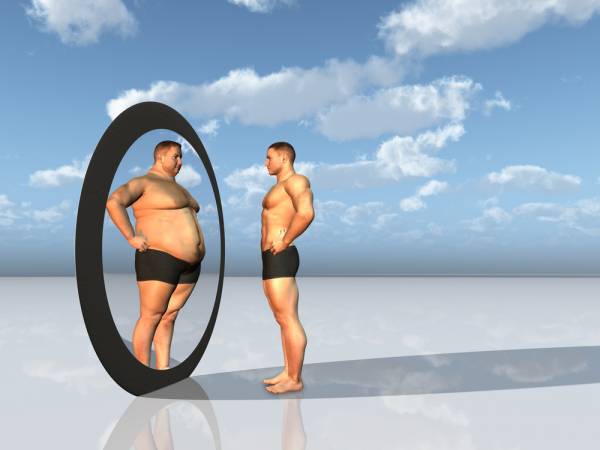We often talk about the female body image. I have written about it as well as many other authors, but what about the male body image? How do today’s standards affect males and how they feel about themselves?
We often talk about the female body image. I have written about it as well as many other authors, but what about the male body image? How do today’s standards affect males and how they feel about themselves?
Many men may say, “I don’t have a problem. I’m great.” Then they go workout for five hours. Is this healthy? When we look at what images our society puts out in the movies – 300, Superman, Spartacus, and Pompeii – what do we see? Men with only five percent body fat, ripped to shreds, and representing an unsustainable way of living.
Both men and women face challenges regarding body image, and it is important to address both sides instead of just one.
Male Body Image and Statistics
The Australian Psychological Society gathered statistics on male body image, including information on the habits of those with body dysmorphic disorder.
According to Helen Fawkner, PhD, research confirms that in recent years the number of men seeking treatment for body-image dissatisfaction has increased.
Traditionally, a male’s role in society has been clearly defined. The “ideal” man offered strength through security.
Today, it seems men feel the need to display strength, security, and masculinity through physical appearance. The statistics are alarming – male body-image dissatisfaction has tripled in the last 25 years, from 15% of the population to 45%.
Here are some other statistics regarding men and the ideal male body:
- One in ten people with anorexia are male.
- 17% of men are on extreme diets.
- 3% of men binge eat.
- 4% of men purge after eating.
- 3% of adolescent boys use performance-enhancing drugs.
Males and Body Dysmorphic Disorder
One form of male body dysmorphic disorder is muscle dysmorphia, a preoccupation that the body is too small and inadequately muscular.
In reality, many of the afflicted men are muscular and large. Compulsive training in the gym is common, as is painstaking attention to diet and dietary supplements. Of particular concern, muscle dysmorphia may lead to the potentially dangerous abuse of performance-enhancing drugs.
The cause of muscle dysmorphia is still relatively unknown, and probably multifactorial, involving genetic-neurobiological, evolutionary, and psychological aspects. Other factors, such as social pressure for boys and men to be large and muscular, contribute to the development of muscle dysmorphia.

The disorder remains under-recognized and under-diagnosed because men are often reluctant to reveal their symptoms due to shame or fear of embarrassment.
Typically, men do not recognize that their beliefs about their appearance may be inaccurate or due to a psychiatric disorder.
How to Know if You Have Muscle Dysmorphia
Many males may be wondering where to draw a line in the sand. Well, those are questions that only you can answer. Some things to think about are:
- Do you go to the gym because you are overly self-conscious about your body and not for overall fitness and health?
- Do you spend several hours in the gym or workout multiple times per day?
- Do you always think you are fat, skinny, or not the “ideal” male?
- Do you have an unhealthy obsession with your diet bordering on the compulsive?
- Have you considered any “dangerous” supplementation such as hormone therapy without the care or prescription of a doctor? Are you using supplements that have been proven to be unhealthy?
- Are you taking diuretics or laxatives for a cosmetic reason?
Some of you may think this list of questions is unreasonable or see nothing wrong with any of it. But if you have all of these symptoms or thoughts, you might have a problem – and there is no shame in that. It is important that you get help if this applies to you.
The Role of Eating Disorders, Body Dissatisfaction, and Attractiveness
The Journal of American College Health investigated the relationship between the risk of eating disorders, body dissatisfaction, and perceptual attractiveness in male university students. The study used 339 males and 441 female students.
Eating disorder risk was assessed with the Eating Attitudes Test (EAT). Body dissatisfaction and perceptual attractiveness were determined with the Bodybuilder Image Grid (BIG).
In the study, 28% of male participants earned an EAT score indicating they were at risk for an eating disorder.
And, ironically, males chose a significantly more muscular and leaner body type as “ideal” than what females chose to be attractive to them. It was concluded from all of this that college age males may be at risk for eating disorders based on distortions in their perceived ideal body image, both for fat and muscle.

It’s Okay to Talk About It
Men and women both share similar concerns when it comes to body image, and it’s important to treat both sexes as equally important. Men may not come out and say they are self-conscious about their bodies, but in reality, some men truly are.
Men, it’s important for you to know what constitutes “healthy” in regards to fitness and diet and what may be extreme to downright unhealthy. If you feel you are more on the unhealthy side, talk to your physician or psychiatrist to understand what a healthy lifestyle could look like for you.
And if someone you have been working with – like a CrossFit coach, personal trainer, exercise physiologist, or nutritionist – approaches you with concerns about your health, be sure to listen.
I know men don’t like to talk about feelings or what is going on inside their heads, but if someone says something to you like, “Hey man, you are going pretty crazy with your diet,” or “Dude, you were in the gym like six times yesterday doing two hour workouts,” it could trigger questions in your mind.
If someone says these sorts of things to you, instead of taking it personally, it may help to think about it and talk to someone about it. It may change – or even save – your life.
References:
1. Mayo, C. and George, V.., “Eating Disorder Risk and Body Dissatisfaction Based on Muscularity and Body Fat in Male University Students.” Journal of American College Health (2014): ePub, accessed June 2, 2014, DOI: 10.1080/07448481.2014.917649
2. Phillips, K. and Castle, D., “Body Dysmorphic Disorder in Men.” British Medical Journal (2001): 1015-1016, accessed June 2, 2014, PMCID: PMC1121529
3. Gregor, Steven. “The Man Behind the Mask: Male Body Image Dissatisfaction.” Australian Psychological Society (2004): ePub, accessed June 2, 2014.
4. Smith, E. and Kosslyn, S., Cognitive Psychology, Mind and Brain, (Upper Saddle River, 2007), 358-360
Photo 1 300 the movie by Attribution-NonCommercial License.
Photos 2 & 3 courtesy of Shutterstock.






